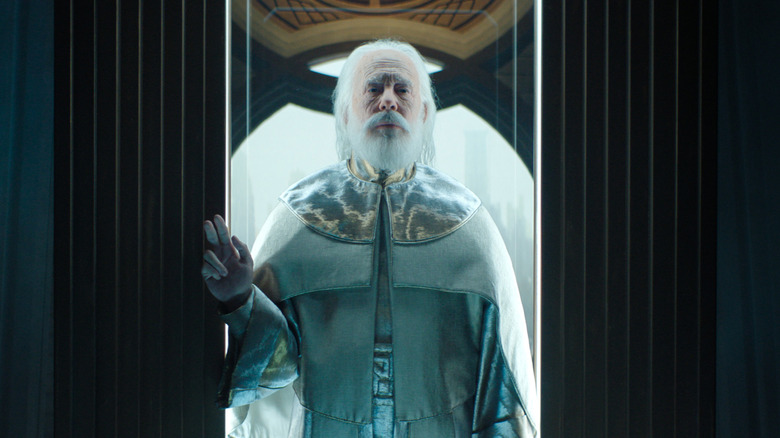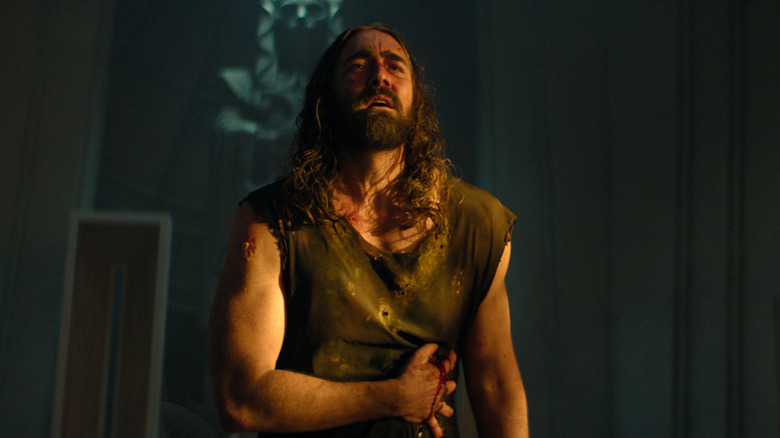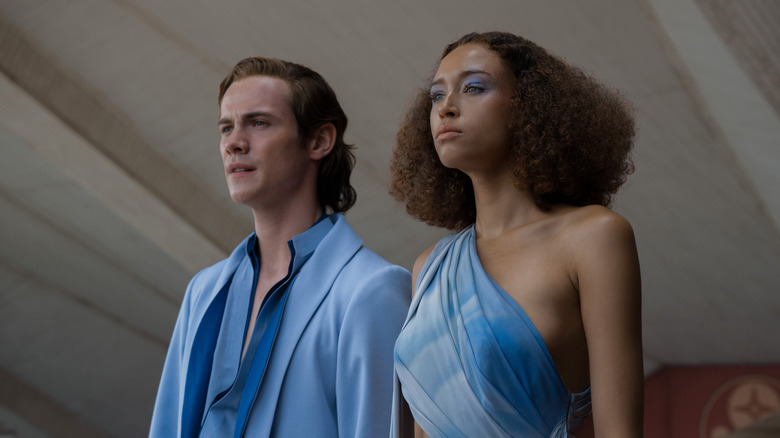How Foundation's Emperor Cleon Differs From Isaac Asimov's Books
"Foundation" is three seasons in (with season 4 in the pipeline), and Apple TV's sci-fi show is a certifiable hit. It's been a slow burn, with season 1 sporting a mediocre 72% score on Rotten Tomatoes as of this writing. Two seasons later, however, that score has risen to 91%. This series is a barnburner, and it's still gaining momentum with lots of story left to tell in season 4 and (possibly) beyond.
One of the key components of the show's success is the compelling tri-part character of Emperor Cleon. The enduring (read: cloned) triple emperor concept is a fun part of "Foundation." Here's the thing, though: It's completely made up for the series. In fact, the emperors of the Galactic Empire play a minimal role in Isaac Asimov's "Foundation" novels. Be that as it may, they're a fascinating part of the TV adaptation.
Also called the Genetic Dynasty, the emperor of the Galactic Empire (in the series) consists of three parts. Brother Dawn (Cassian Bilton) is the youngest and up-and-coming emperor in training. Meanwhile, Brother Day (Lee Pace) is the active and current emperor overseeing the crumbling empire. Finally, Brother Dusk (Terrence Mann) is the retired, counselor-type leader offering experienced wisdom at the top of the Imperial org chart. Of course, there's also Brother Darkness (Mann, again), who shows up briefly in the dramatic season 3 finale, annihilates the dynasty (with the exception of a forgotten Brother Dawn recovering from his wounds above New Terminus), and attempts to kill Demerzel (Laura Birn). (Don't worry, she'll be back.)
If this interesting and integral clone setup is completely made up for the TV show, how are the "Foundation" books different? I'm glad you asked. Let's dig in, shall we?
Cleon's involvement in the story of Foundation
"Supressing a small yawn, Cleon said, 'Demerzel, have you by any chance ever heard of a man named Hari Seldon?'"
That's the opening line of "Prelude to Foundation," the first of two prequel novels in Asimov's iconic sci-fi property. This is also the only place where we actually get to know the Emperor. Admittedly, we get to know Eto Demerzel (Laura Birn in the TV adaptation) a lot more in the prequels, whereas both characters are literally off-screen and largely irrelevant for 99% of the main books.
The opening line of the first prequel novel is where we start to really get a picture of what life is like at the top of the Imperial system. We also get this brief summary of Cleon I:
CLEON I — [...] The last Galactic Emperor of the Entun Dynasty. He was born in the year 11988 GE, the same year in which Hari Seldon was born. (It is thought that Seldon's birthdate, which some consider doubtful, may have been adjusted to match that of Cleon, whom Seldon, soon after his arrival on Trantor, is supposed to have encountered.)
There's a summary of his relatively peaceful reign, too:
Having succeeded to the Imperial throne in 12010 GE at the age of twenty-two, Cleon I's reign represented a curious interval of quiet in those troubled times. This is undoubtedly due to the skills of his Chief of Staff, Eto Demerzel, who so carefully obscured himself from public record that little is known about him.
See the inspiration for the show in there? Demerzel shrouds the genetic dynasty in mystery. Cleon is also the primary Galactic figurehead whom Seldon interacts with. The main difference? Cleon's way more involved in the "Foundation" TV series. Oh, and he's a clone.
How Cleon the clone came to be on Foundation
The cloning of the genetic dynasty is the most obvious difference between Cleon in the books and the string of Cleons in the "Foundation" TV series. In the books, Cleon I is a distinct leader with basic things like a personal history and, you know, a normal lifespan. Obviously, this was changed for the show, where there's an endless string of reproduced clones that can be decanted at a moment's notice to keep Empire looking spotless and shiny.
According to "Foundation" co-creator David S. Goyer, this element was part of a push to complement some of the concept-heavy stuff in Asimov's books with some recognizable and consistent characters. As he told The Hollywood Reporter in 2021:
"I figured out a way to have some of the characters extend their lifespans. About six characters will continue from season to season, from century to century. That way it becomes a half anthological, half continuing story."
My guess is that the three of those perpetual characters are Seldon (Jared Harris), Gaal Dornick (Lou Llobel), and Demerzel. Presumably, the other three are the generational iterations of Cleon. While it's a deviation from the source material, cloning Cleon has been a fantastic way to let the character shine. It's also given us a much deeper connection to and understanding of the collapsing Galactic Empire than we get in the books. No clones there. Once Cleon's gone, he's gone. While I tend to favor books over adaptations, I have to admit: Building out Cleon's character through the clone storyline has been one of the best parts of the "Foundation" TV show, and it is a great way to tie in the hints and details revealed in the prequels without too much exposition. Well done, Goyer. Well done.


